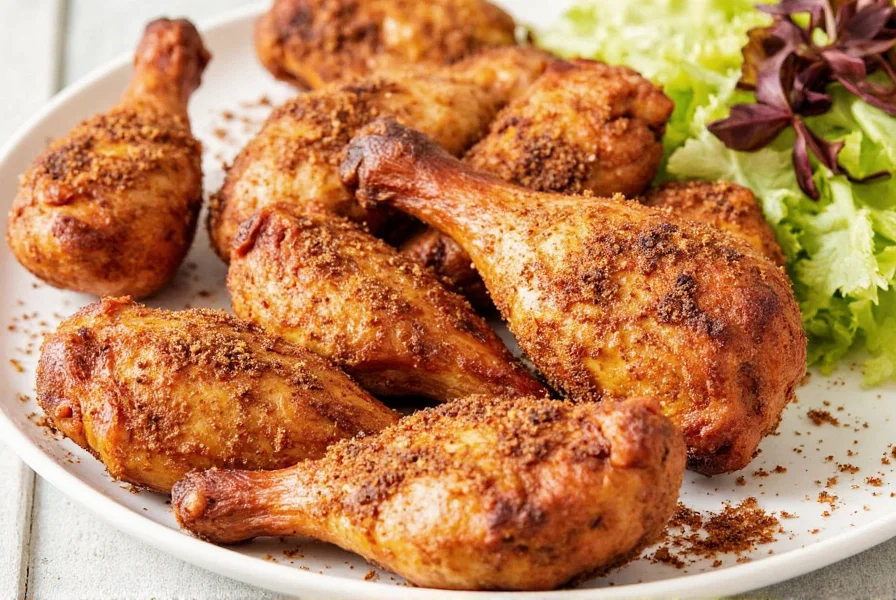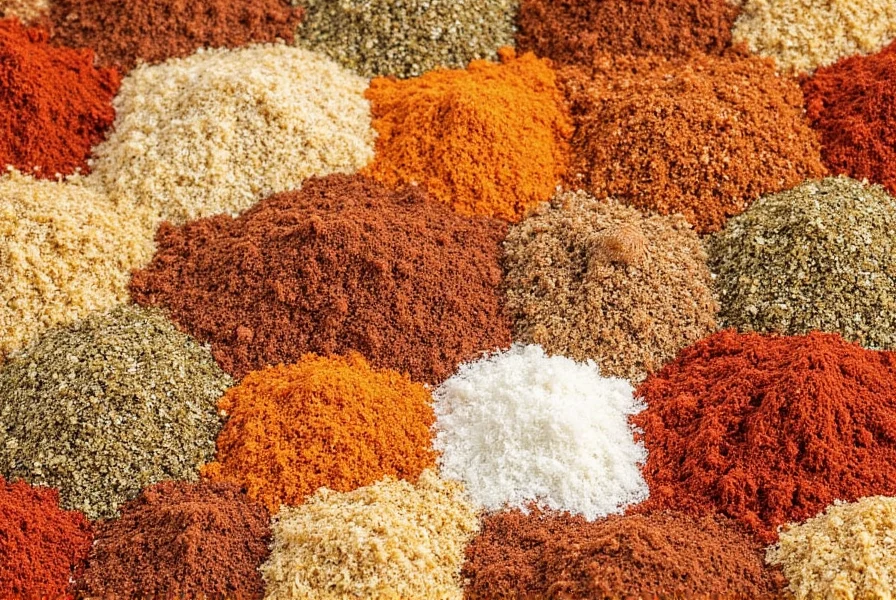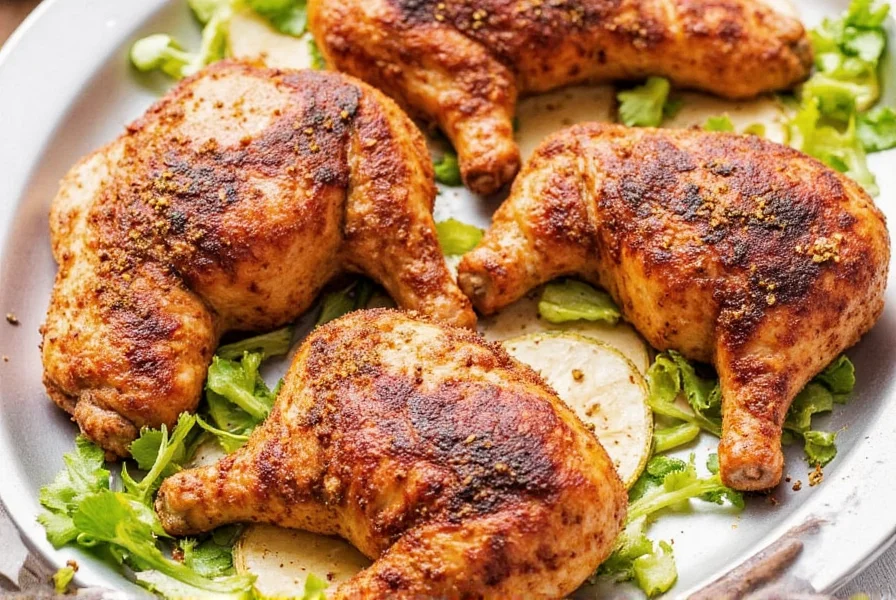What Is a Chicken Spice Rub and Why It Matters
A chicken spice rub is a dry mixture of herbs, spices, salt, and sugar applied to chicken before cooking to enhance flavor and create a delicious crust. Unlike marinades, rubs work quickly and are ideal for grilling, smoking, baking, or air-frying. This guide covers everything you need to know about chicken spice rubs, from what they are to how to make and use them effectively for perfect results every time.
What Exactly Is a Chicken Spice Rub?
In the simplest terms, a chicken spice rub is a dry mixture of herbs, spices, salt, sugar, and sometimes aromatic powders like garlic or onion. Unlike marinades, which rely on liquids to infuse flavor, rubs work by creating a flavorful crust directly on the surface of the chicken.
Rubs can be applied anywhere from minutes to hours before cooking. The longer they sit, the more time the flavors have to penetrate the meat—though in most cases, even a quick 30-minute rest does wonders.
The Science Behind Flavor Infusion
You might think of rubs as just sprinkling spices on meat, but there's some fascinating science happening under your fingertips:
- Salt: Draws moisture out, then dissolves back into the meat, carrying flavor deep inside.
- Spices: Contain volatile oils that vaporize during cooking, releasing aromas that heighten flavor perception.
- Time: Even short rests allow spices to bind with the meat's proteins for better flavor retention.
This is why a well-formulated chicken spice rub doesn't just sit on top—it becomes part of the dish itself.
How to Choose the Right Chicken Spice Rub for You
Choosing a rub can feel overwhelming when faced with so many options on store shelves—or recipes online. Let's break it down into key criteria to help you pick the perfect one:
| Criterium | Description | Why It Matters |
|---|---|---|
| Flavor Profile | Is it smoky, sweet, spicy, savory, or herbal? | Determines if it complements your meal style (BBQ, Asian fusion, etc.) |
| Grill Compatibility | Can it withstand high heat without burning? | Some sugars and delicate spices can burn quickly at high temps. |
| Purpose | Is it meant for whole birds, wings, thighs, or strips? | Different cuts absorb and showcase flavors differently. |
| Preparation Time | Does it need marinating time or can you cook immediately? | For busy cooks, a quick rub is ideal. |
| Dietary Preferences | Gluten-free, vegan, low-sodium, or preservative-free options? | Accommodates special diets or health goals. |
Top 10 Chicken Spice Rubs We Love (And Why)
Let's dive into the stars of the show! Here are ten standout chicken spice rubs across different flavor profiles and use cases:
- Classic Smoky BBQ Rub: A blend of paprika, brown sugar, garlic powder, cumin, chili powder, and smoked salt. Great for slow-smoked drumsticks.
- Lemon & Herb Delight: Lemon zest, thyme, rosemary, oregano, black pepper, and sea salt. Perfect for roasted breasts or kebabs.
- Southern Soul Rub: Combines cayenne, celery salt, mustard powder, onion powder, black pepper, and coarse salt. Ideal for fried chicken seasoning prep.
- Caribbean Jerk Rub: Scotch bonnet, thyme, allspice, cinnamon, nutmeg, cloves, and brown sugar. Excellent for tropical-style grilled thighs.
- Mediterranean Magic Mix: Oregano, sumac, lemon zest, garlic, fennel seeds, and coriander. Works beautifully with olive oil-based roasting.
- Texas Heat Rub: Chili powder, cumin, smoked paprika, chipotle, garlic, and a hint of cocoa. Pairs perfectly with smoked chicken.
- Korean-Style Gochugaru Rub: Korean red pepper flakes, sesame seeds, garlic, ginger, and brown sugar. Best used on grilled chicken skewers.
- Italian Seasoned Rub: Basil, parsley, garlic powder, onion powder, black pepper, and Parmesan cheese (optional). Ideal for oven-baked tenders.
- Moroccan Ras El Hanout Rub: Cinnamon, ginger, cumin, coriander, turmeric, cardamom. Works wonderfully with apricot glaze or couscous sides.
- Teriyaki Dry Rub: Soy sauce powder, ginger, garlic, sesame seeds, brown sugar. Fantastic for searing or stir-fry applications.
DIY Chicken Spice Rub: How to Create Your Own Custom Blend
Ready to level up? Creating your own custom chicken spice rub lets you tailor every flavor element to your preferences. Here's how to do it:
Step 1: Start With a Base
- Salt (kosher or sea salt): 2–4 tablespoons
- Brown sugar (for balance and caramelization): 1–2 tablespoons
Step 2: Add Herbs & Spices
- Greek or Italian blends: basil, oregano, thyme, parsley
- Southwestern vibes: chili powder, paprika, cumin, cayenne
- Asian-inspired: ginger, garlic, five-spice powder, sesame seeds
Step 3: Boost the Aroma
- Freshly ground black pepper
- Garlic powder
- Onion powder
Step 4: Optional Flavors
- Citrus zest
- Nutmeg or cinnamon (for warmth)
- Dried mushroom powder (adds umami)
Step 5: Mix and Store
Mix all ingredients thoroughly in a bowl. Store in an airtight container away from sunlight. Use within 6 months for optimal potency.

Pro Tips for Using Chicken Spice Rub Like a Boss
- Pat dry first: Always pat chicken pieces dry before applying rub. Moisture repels spices!
- Use gloves: Not only keeps hands clean but also ensures even pressure and coverage.
- Don't skimp: A thin layer won't cut it. Rub generously to ensure full coverage.
- Rest time matters: Let chicken sit for 15–60 minutes after applying rub for deeper flavor penetration.
- Pair with fat: Lightly coat with oil before rubbing to help spices stick and brown evenly.
Buying Guide: What to Look for When Purchasing a Chicken Spice Rub
If making your own rub isn't your thing, store-bought blends can still deliver excellent results. Here's how to choose wisely:
1. Ingredient Quality
Look for fresh, whole spices and avoid fillers like anti-caking agents or excessive salt unless specified. Organic or non-GMO certifications add value.
2. Shelf Life
Whole spices last longer than ground ones. Check expiration dates and opt for vacuum-sealed containers if possible.
3. Brand Reputation
Trusted brands like Penzey's, The Spice Hunter, and Badia offer consistent quality and bold flavors tailored to specific cuisines.
4. Allergens & Dietary Considerations
Many brands now cater to gluten-free, vegan, and kosher needs. Always read labels carefully if you have dietary restrictions.
5. Reviews & Tasting Notes
Online reviews or tasting notes from culinary blogs can guide you toward the best-tasting rubs for your preferred cuisine or occasion.
Common Mistakes to Avoid with Chicken Spice Rubs
Even seasoned grillers can slip up. Here are some common mistakes and how to avoid them:
- Using too much salt: Can overpower other flavors. Taste-test your mix before applying.
- Applying on wet meat: Spices don't stick well to moisture. Pat dry before rubbing.
- Burning the rub: Sugar-heavy rubs can char quickly on high heat. Adjust temperature accordingly.
- Over-seasoning dark meat: Thighs and legs absorb flavor more readily. Use slightly less on these cuts.
- Storing improperly: Keep in cool, dark places. Exposure to light and humidity reduces potency.

Frequently Asked Questions About Chicken Spice Rubs
How long should I leave a spice rub on chicken before cooking?
For optimal flavor, let the rub sit on chicken for at least 30 minutes to 1 hour before cooking. For even better results, refrigerate it for 4-12 hours. The salt in the rub will help break down proteins and allow flavors to penetrate deeper into the meat.
Can I use a dry rub instead of a marinade for chicken?
Absolutely! Dry rubs are excellent alternatives to marinades. While marinades use liquid to infuse flavor, dry rubs create a flavorful crust on the surface of the chicken. Rubs work particularly well for grilling and smoking where you want that beautiful sear and bark formation.
What's the difference between a dry rub and a wet marinade?
Dry rubs are mixtures of dry spices and seasonings that form a crust on the meat's surface, while marinades are liquid-based mixtures that tenderize and flavor meat through soaking. Rubs work faster, don't require as much preparation time, and create that desirable textured crust that many BBQ enthusiasts love.
How much rub should I use per pound of chicken?
As a general rule, use about 1 tablespoon of rub per pound of chicken. Don't be shy—apply generously to ensure full coverage. Remember to pat the chicken dry first so the rub adheres properly. For larger cuts like whole chickens, you may need up to 3-4 tablespoons total.
Do I need to add oil when using a dry rub?
While not strictly necessary, lightly coating chicken with oil (about 1 teaspoon per pound) before applying the rub helps the spices adhere better and promotes even browning. The oil also helps prevent the rub from burning on high-heat cooking methods like grilling.
Can I make my own spice rub at home?
Definitely! Homemade rubs allow you to customize flavors to your preference and avoid preservatives or unnecessary additives. Start with a base of salt and sugar, then add your favorite herbs and spices. The DIY section earlier in this article provides a step-by-step guide to creating your perfect blend.
How long do homemade spice rubs last?
When stored properly in an airtight container away from light and moisture, most homemade spice rubs maintain their potency for 6-12 months. Rubs containing sugar may last slightly longer, while those with fresh ingredients like citrus zest should be used within 1-2 months for best flavor.
Should I rinse off the rub before cooking?
No, you should never rinse off a dry rub before cooking. The purpose of the rub is to create a flavorful crust on the chicken's surface. Rinsing would remove all the carefully applied seasoning. Simply apply the rub, let it rest for the recommended time, and cook as directed.
Conclusion: Unlock Bold Flavors with the Right Chicken Spice Rub
Whether you're hosting a backyard barbecue or prepping dinner on a weeknight, a good chicken spice rub can turn ordinary poultry into something extraordinary. From choosing the right blend to crafting your own DIY mixes, there's no shortage of ways to elevate your cooking game.
Remember: the best rub is the one that makes your taste buds sing. So go ahead, experiment, explore, and above all—have fun with it. After all, great food starts with great flavor… and a little sprinkle of love.











 浙公网安备
33010002000092号
浙公网安备
33010002000092号 浙B2-20120091-4
浙B2-20120091-4